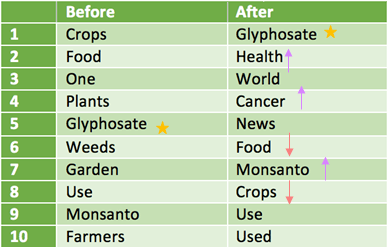By Lindsay Pollard, University of Saskatchewan
After an IARC decision, has 2A changed how we view glyphosate?
In April 2015, SAIFood ran the blog, “Who to Believe in the Glyphosate Debate”, which looked at IARC’s classification of glyphosate as 2A, probably carcinogenic to humans. Since then the conversation around the chemical appears to have changed, but how? A discourse analysis surrounding the language written or vocalised surrounding a topic can be examined to determine how the conversations around glyphosate have changed.
To conduct this analysis, I have begun with seeking out conventional newspapers, as they have the widest reaching audiences and demographics. In addition, newspaper articles will pull information from a number of sources, as well they are timely, and can be posted online or shared through social media. The big question of how has the discourse around glyphosate has changed can be broken down into some more specific questions:
[su_list icon=”icon: angle-double-right” icon_color=”#538b1b”]
- What was being said about glyphosate?
- How did that change between periods?
- Was in in a negative, positive or neutral way?
- Was there a pattern of conversations depending on the region the source came from?
[/su_list]
To evaluate the change, the newspaper articles were split into two periods, before and after the release of the IARC report. For symmetry, a two-year period leading up to March 20, 2013, formed the before, and from March 20, 2015, until March 20, 2016, became the after. NVivo, a qualitative research analysis software, has been used to perform the analysis, and remained of this post will look at my findings so far in the early stages of this project.
Early on the decision was made to focus on sources from North America and Europe. Based on rates of circulation, only articles from the top 5 newspapers from North American and Europe were searched. Articles that contained the word glyphosate were analysed. By fluke, 89 articles were found in both time periods. These articles were almost an even split between North American and European papers.
Key shifts in context
Over the course of the two time periods, the number of times the word glyphosate appeared more than double from before March of 2015 to after. Okay so it doubled, but what does that matter? Is it a good thing or is it a bad thing? To determine that, the context in which ‘glyphosate’ was used needs to be reviewed. The context shows that there was a difference in what was being said before and after. The trend of the before period talked about glyphosate’s use in gardens, weed resistance or ‘superweeds’, and how glyphosate was harmful to monarch butterflies. Not surprisingly after the release of the IARC report, the context focused on glyphosate being carcinogenic and Monsanto, the company that patented the pesticide.
 By reviewing of the most frequently used words, the contextual shift is confirmed. The table to the right shows how glyphosate became the most used word of the articles post-IARC report. Suggests that once the IARC report came out, our conversations around glyphosate increased. After IARC’s report, cancer and health became more heavily used, while plants, weeds, and gardens decline in the articles. Suggesting that the conversations leading from glyphosate newspaper articles would have an increased focus surrounding the health and cancer concerns of glyphosate. Prior to IARC’s report, health-related topics were not the topic points of many of the glyphosate related articles, therefore confirming a shift in discourse.
By reviewing of the most frequently used words, the contextual shift is confirmed. The table to the right shows how glyphosate became the most used word of the articles post-IARC report. Suggests that once the IARC report came out, our conversations around glyphosate increased. After IARC’s report, cancer and health became more heavily used, while plants, weeds, and gardens decline in the articles. Suggesting that the conversations leading from glyphosate newspaper articles would have an increased focus surrounding the health and cancer concerns of glyphosate. Prior to IARC’s report, health-related topics were not the topic points of many of the glyphosate related articles, therefore confirming a shift in discourse.
While this research is ongoing as my undergraduate thesis, it appears so far that the IARC report has changed how we discuss glyphosate. Research like this is important in many ways, it can provide insight on consumers and how one report can influence regulatory bodies.

Lindsay Pollard
Lindsay has just started her fourth and final year of the Agribusiness degree at the College of Agriculture and Bioresources at the University of Saskatchewan. Originally from Sidney, British Columbia, Lindsay spent much of her childhood running around her cousin’s cattle farm. She says she is interested in agriculture policy, especially the effects it has on industry and consumers. One day she hopes to end up working in a position analyzing policy or creating it.


Call me cynical but that is exactly what Pottier et al hoped for when they made their (in many minds bogus) determination.